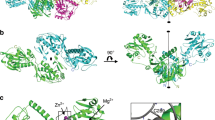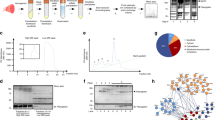Abstract
The primary sequence of two components of the dystrophin–glycoprotein complex has been established by complementary DNA cloning. The transmembrane 43K and extracellular 156K dystrophin-associated glycoproteins (DAGs) are encoded by a single messenger RNA and the extracellular 156K DAG binds laminin. Thus, the 156K DAG is a new laminin-binding glycoprotein which may provide a linkage between the sarcolemma and extracellular matrix. These results support the hypothesis that the dramatic reduction in the 156K DAG in Duchenne muscular dystrophy leads to a loss of a linkage between the sarcolemma and extra-cellular matrix and that this may render muscle fibres more susceptible to necrosis.
This is a preview of subscription content, access via your institution
Access options
Subscribe to this journal
Receive 51 print issues and online access
$199.00 per year
only $3.90 per issue
Buy this article
- Purchase on Springer Link
- Instant access to full article PDF
Prices may be subject to local taxes which are calculated during checkout
Similar content being viewed by others
References
Hoffman, E. P., Brown, R. H. & Kunkel, L. M. Cell 51, 919–928 (1987).
Koenig, M., Monaco, A. P. & Kunkel, L. M. Cell 53, 219–228 (1988).
Arahata K. et al. Nature 333, 861–866 (1988).
Hoffman, E. P. et al. N. Engl. J. Med. 318, 1363–1368 (1988).
Watkins, S. C., Hoffman, E. P., Slayter, H. S. & Kunkel, L. M. Nature 333, 863–866 (1988).
Cooper, B. J. et al. Nature 334, 154–156 (1988).
Campbell, K. P. & Kahl, S. D. Nature 338, 259–262 (1989).
Ervasti, J. M., Ohlendieck, K., Kahl, S. D., Gavet, M. G. & Campbell, K. P. Nature 345, 315–319 (1990).
Ervasti, J. M. & Campbell, K. P. Cell 66, 1121–1131 (1991).
Ohlendieck, K., Ervasti, J. M., Snook, J. B. & Campbell, K. P. J. Cell Biol. 112, 135–148 (1991).
Ohlendieck, K. & Campbell, K. P. FEBS Lett. 283, 230–234 (1991).
Ohlendieck, K. & Campbell, K. P. J. Cell Biol. 115, 1685–1694 (1991).
Devi, L. FEBS Lett. 280, 189–194 (1991).
Ehrig, K., Leivo, I., Argraves, W. S., Ruoslahti, E. & Engvall, E. Proc. natn. Acad Sci. U.S.A. 87, 3264–3268 (1990).
Hunter, D. D., Shah, V., Merlie, J. P. & Sanes, J. R. Nature 338, 229–234 (1989).
Sanes, J. R., Engvall, E., Butkowsky, R. & Hunter, D. D. J. Cell Biol. 111, 1685–1699 (1990).
Hassell, J. R., Kimura, J. H. & Hascall, V. C. A. Rev. Biochem. 55, 539–567 (1986).
Höök, M., Kjellén, L., Johansson, S. & Robinson, J. A. Rev. Biochem. 53, 847–869 (1984).
Lesot, H., Kühl, U. & von der Mark, K. EMBO J. 2, 861–865 (1983).
Clegg, D. O., Helder, J. C., Hann, B. C., Hall, D. E. & Reichardt, L. F. J. Cell Biol. 107, 699–7095 (1988).
Mecham, R. P. FASEB J. 5, 2538–2546 (1991).
Volk, T., Fessler, L. I. & Fessler, J. H. Cell 63, 525–536 (1990).
Smalheiser, N. R. & Schwartz, N. B. Proc. natn. Acad. Sci. U.S.A. 84, 6457–6461 (1987).
Menke, A. & Jockusch, M. Nature 349, 69–71 (1991).
Franco, A. & Lansman, J. B. Nature 344, 670–673 (1990).
Turner, P. R., Fong, P., Denetclaw, W. F. & Steinhardt, R. A. J. Cell Biol. 115, 1701–1712 (1991).
Bonilla, E. & Moggio, E. Neurology 36, 171 (1986).
Carpenter, S. & Karpati, G. Brain 102, 147–161 (1979).
Kyte, J. & Doolittle, R. F. J. molec. Biol. 157, 105–132 (1982).
Jay, S. D. et al. Science 248, 490–492 (1990).
Sanger, F., Nicklen, S. & Coulson, A. R. Proc. natn. Acad. Sci. U.S.A. 74, 5463–5467 (1977).
Smith, D. B. & Johnson, K. S. Gene 67, 31–40 (1988).
Gorka, J., McCourt, D. W. & Schwartz, B. D. Peptide Res. 2, 1–5 (1989).
McPherson, P. S. et al. Neuron 7, 17–25 (1991).
Laemmli, U. K. Nature 227, 680–685 (1970).
Campbell, K. P. et al. J. biol. Chem. 262, 6460–6463 (1987).
Author information
Authors and Affiliations
Rights and permissions
About this article
Cite this article
Ibraghimov-Beskrovnaya, O., Ervasti, J., Leveille, C. et al. Primary structure of dystrophin-associated glycoproteins linking dystrophin to the extracellular matrix. Nature 355, 696–702 (1992). https://doi.org/10.1038/355696a0
Received:
Accepted:
Issue Date:
DOI: https://doi.org/10.1038/355696a0
This article is cited by
-
Altered muscle niche contributes to myogenic deficit in the D2-mdx model of severe DMD
Cell Death Discovery (2023)
-
Myoscaffolds reveal laminin scarring is detrimental for stem cell function while sarcospan induces compensatory fibrosis
npj Regenerative Medicine (2023)
-
Involvement of abnormal dystroglycan expression and matriglycan levels in cancer pathogenesis
Cancer Cell International (2022)
-
Global prevalence of Duchenne and Becker muscular dystrophy: a systematic review and meta-analysis
Journal of Orthopaedic Surgery and Research (2022)
-
The cell adhesion protein dystroglycan affects the structural remodeling of dendritic spines
Scientific Reports (2022)
Comments
By submitting a comment you agree to abide by our Terms and Community Guidelines. If you find something abusive or that does not comply with our terms or guidelines please flag it as inappropriate.



